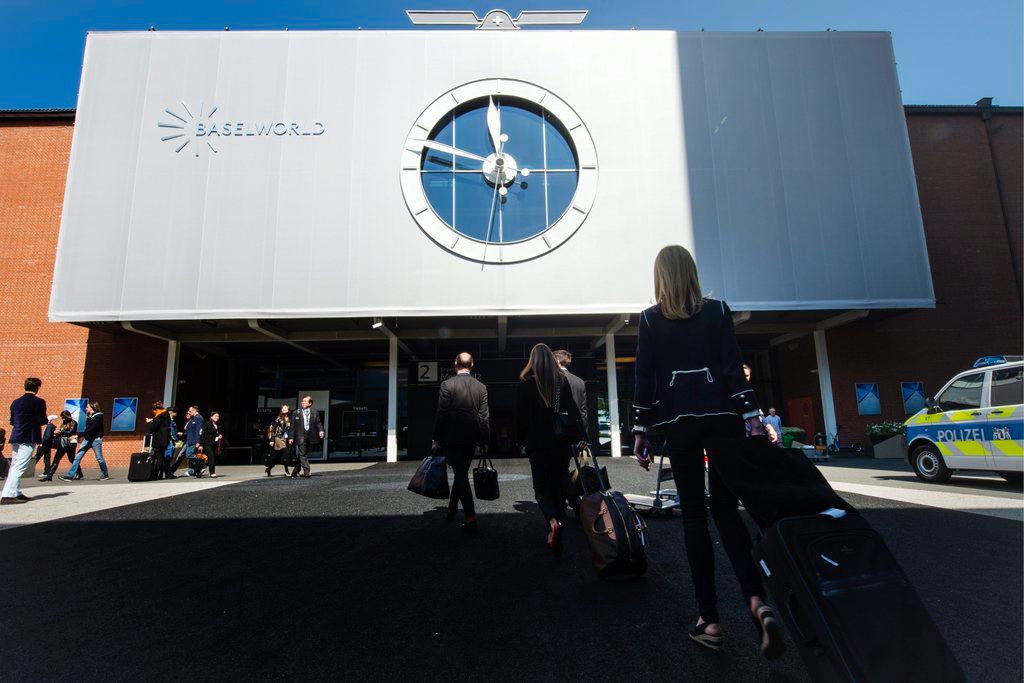Lack of marketing clout threat to boutique watchmakers

Small scale Swiss watchmakers fear that a mismatch in promotional spending power with larger rivals poses a greater threat to their survival than declining Asian demand or the strong franc. Many independent brands could soon go out of business as a result.
Neuhausen-based H Moser, is a family owned brand producing around 1,000 watches a year, including the Funky Blue Endeavour Perpetual Calendar with a calendar mechanism that recognises leap years and the differing lengths of months.
Chief executive Edouard Meylan believes that 90% of struggling watchmakers might not survive the next few years. Already, more than half of the new brands created globally each year disappear from view within five years, he told swissinfo.ch.
Competing against the big firms, which have growing marketing budgets, is becoming more difficult – and so are the prospects of finding a larger company to take them over. “That’s why, out of 10 brands, if one survives then that’s already a lot,” he said.
Small and medium sized enterprises (SMEs) and micro firms with fewer than 10 employees make up the bulk of Switzerland’s 572 watchmakers. Unfriendly market conditions are drawing comparisons with the 1970s quartz watch crisis that saw many of the then 1,600 firms disappear in Switzerland.
Today’s headlines have centered on the negative effects of the strong franc “tsunami” (a term coined by Swatch group chief executive Nick Hayek), the Chinese corruption crackdown on expensive gift watches and political protests in Hong Kong.
Income from exports (see box below) has declined despite more watches being sold. This is because more customers are buying Swiss watches in the eurozone or Britain at lower prices than in Switzerland.
At the same time, exports to Hong Kong, by far the largest single market for Swiss watches, fell by nearly a fifth in the first six months of 2015. Swatch group profits declined -8.3% in this period while Swiss multinational DKSH decided to ditch its loss-making Maurice Lacroix luxury watch brand due to “substantially lower demand in Asia”.
Glitzy campaigns
But the picture is different for many smaller brands. “Our members are not so greatly affected by economic volatility as large watchmakers,” Daniel Rincon Hanna, event organizer for the Académie Horlogère des Créateurs Indépendants (AHCI) – or Independent Watchmakers Association – told swissinfo.ch.
“They are selling their creations to very wealthy people who spend CHF150,000 on a watch – this is a drop in the ocean for them. Such people are not so affected by temporary economic downturns.”
In addition, lesser known brands are not so badly affected by the Chinese corruption crackdown, Hanna added. “People in Asia who accept watches as bribes are attracted to the famous brands – the status and bling factor,” he said.
The strong franc is more of an issue for H Moser, an SME based in Neuhausen that sells 1,000 watches a year and generates CHF20 million in turnover. Edouard Meylan was so incensed by the Swiss National Bank’s decision on January 15 to abandon its franc-euro exchange rate cap that he wrote an open letter to the media decrying the possible consequences for his firm.
He now credits that letter, which made a lot of headlines, for helping the company out of a fix. “It helped us get more visibility, meet more clients, get more accounts. It generated ‘sympathy capital’ for the brand.”

But while H Moser is benefiting from this unexpected boost, Meylan believes that for the Swiss industry as a whole “the reality is that the market is tougher than export statistics show.” A greater threat than even the strong franc and falling Asian demand is the growing ability of large firms to grab attention for their brands through glitzy and expensive promotional campaigns.
Big brand magnetism
The world’s largest watch brands are queuing up to sign Hollywood actors, sports stars and other A-list celebrities onto their payroll to promote their latest products. The strategy is proving highly successful, but the fees demanded by household names are way out of reach for small competitors.
“The luxury industry in general is abusing the system,” said Meylan. “Communication budgets are huge, but customers sometimes don’t understand the real intrinsic value, the legitimacy and authenticity of the brand they are buying.”
Daniel Rincon Hanna agrees. AHCI helps to arrange smaller, more exclusive trade fairs for its members than the huge Baselworld event staged in Switzerland every year. “Baselworld pavilion is like a carnival,” Hanna said. “Small watchmakers attending this event can get overshadowed by the power and magnetism of the big brands.”
The answer for independents is to club together to save costs on attending exhibitions, setting up distribution channels and on promotional activities. Another key to survival, according to Hanna, is to specialise further into smaller niche areas and become ever more exclusive.
Above all, the difference between success and failure for micro firms lies in personal, face-to-face contact with clients. “The watchmaker tells the story behind the watch in person. No-one else can convey that passion. Once the client understands the watchmaker’s philosophy then he falls in love with the product,” said Hanna.
“You don’t have to create something 100% new that requires millions of francs in investment,” said Edouard Meylan. “Sometimes it is enough to come up with smart ideas that play on current topics.”
The demand for handmade luxury watches has not faded. In fact, in the absence of many other reliable investment opportunities, such creations are seen by the wealthy as a value enhancing place to park some of their money.
Nevertheless, the economics of producing such labour intensive objects coupled with the difficulty of competing with larger firms has made industry survival tougher, argues Hanna.
“It is becoming harder and harder for watchmakers to remain truly independent,” he said. “Without a certain scale it is mission impossible. One of our members recently said to me: ‘I have put in 30 years of personal sacrifice to build my brand. If I had to start from scratch now, I would think twice.”
Swiss watch exports
The watch industry has been one of the stars of the Swiss economic landscape since the financial crisis and consequent global economic slowdown. As other sectors were stagnating due to the strengthening franc and economic malaise, the value of watch exports shot up 22.8% in 2010, by 19.5% the year later and 11.6% in 2012.
But the Swiss watch industry’s stellar performance in recent years has started to slow, according to export figures from the Federation of the Swiss Watch Industry. Exports account for 95% of all Swiss watch sales.
In the first six months of 2015, more than 13.5 million Swiss wrist watches were sold abroad, an increase of 3.2% on the same period in 2014. But despite this increase in unit sales, income declined marginally by -0.3% (CHF9.91 billion).
By contrast, sales to Europe rose by more than 10% as customers chose to buy Swiss watches less expensively in eurozone countries compared Switzerland.

In compliance with the JTI standards
More: SWI swissinfo.ch certified by the Journalism Trust Initiative




You can find an overview of ongoing debates with our journalists here. Please join us!
If you want to start a conversation about a topic raised in this article or want to report factual errors, email us at english@swissinfo.ch.